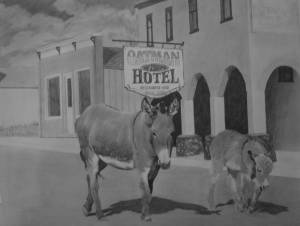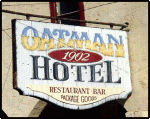You are currently browsing the monthly archive for March 2009.
I love it when I can leave my “normal” 60 hour-a-week job and still have sunshine by the time I get home! I think for many, people enjoy the ability to do things after dinner. I see so many more people running, walking their dogs, and just enjoying the outdoors, compared to just a couple of weeks ago.
For me, this marks the beginning of my most productive time of all. I am a highly-energetic person, and love the ability to cram in tons of fun things. Now that the cold is (hopefully) gone, I can already feel my creative juices starting to flow.
“Grandpa & Andy” as well as “Dancing Cranes” are the two pieces that I have already created for the month of March. (I will be showing these two pieces off quite soon).
I am so excited to get started on my next piece of artwork, which is a commission. It has the earmarks of being a challenge for me, because it is a picture taken from an Equitation competition.
Also buzzing around in my head are ideas involving a fundraiser for a local Equestrian Therapeutic Clinic, that helps children and adults through equine oriented activities.

Map near Four Corners & Canyon de Chelly
And lastly, my husband and I are planning a trip in May to the four corners of the U.S., as well as exploring the Canyon de Chelly area. If you have not heard of this area, it is rich with Navajo and Anasazi history. I hope to be able to take plenty of pictures for future drawings.
If you have been to this area, and know of other fantastic sights to be seen, please leave a comment, and let me know!

Baby Jennie
You might be wondering why a history lesson of Oatman, Arizona could possibly be relevant in this newsletter. Several months ago, my husband and I happened upon Oatman. It’s a cute little ghost town, but the burros really make the town something special. Apparently they meander down from the mountains in the morning, eat all day in town. Late afternoon, the burros start their trek back into the mountains.

Oatman Hotel
OATMAN, ARIZONA
ELEVATION 2700 FEET
Reportedly named after a woman who was captured and later released by the Mohave Indians, Oatman is still alive today. Strike after strike kept Oatman alive, the biggest seems to be the 1915 strike, worth $14 million. The population of Oatman went from a few hundred to over 3500 within a year which lead to long waits at the restaurants. In 1921, a fire burned much of Oatman, but the town was rebuilt.
Oatman was originally named Vivian, after Vivian Mining Company. A gentleman by the name of Ben Taddock found gold in 1902 while he was walking. Taddock sold his loot the following year to a judge, who turned around and sold the gold in 1905 to Vivian Mining Company who started mining in that area. In 1906, Vivian was a big tent town, flourishing as a miner community. In 3 years, the mine produced more than $3 million in gold. The second goldmine was discovered in 1908, and the town of Vivian became a huge boomtown. In 1908 the town was renamed to Oatman.
By 1931 the area’s mines had produced 1.8 million ounces of gold. By the mid 1930’s, the boom was over and in 1942 the last remaining mines were closed. After the mines closed, the town survived for several years due in part to the old Rte 66. Travelers stopped in Oatman as a last stop before they crossed a long and dangerous Mohave desert. Oatman, once a town with 10.000 citizens was in 1950 reduced to 60, when the town was passed by the new US 66.
Burros first came to Oatman with early day prospectors. The animals were also used inside the mines for hauling rock and ore. Outside the mines, burros were used for hauling water and supplies. As the mines closed and people moved away, the burros were released into the surrounding hills. The burros you meet today in Oatman, while descendants of domestic work animals are themselves wild– they will bite and kick.

Recent Comments